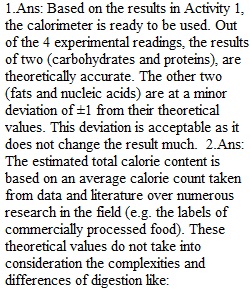


Q Please complete Lab Report 2 based on the Virtual Lab 2 Calorimetry.
Q Calorimetry Lab Report Activity 1 Calibrating the Calorimeter Record your data from Activity 1 in the table below. Calculate the theoretical Calories of samples based on the information given below. Sample Carbohydrates (10g) Fat (10g) Protein (10g) Nucleic Acids (10g) Experimental Calories 40 calories 89 calories 40 calories 41 calories Theoretical Calories 40 calories 90 calories 40 calories 40 calories Show Calculation for the protein sample: 1 gram of protein sample = 4 calories Therefore, 10 grams of protein sample = (4 calories)/(1 gm) x 10 gm = 40 calories Calories per gram of food molecules: Carbohydrates: 1 gram = 4 calories Fat: 1 gram = 9 calories Protein: 1 gram = 4 calories Nucleic Acids: 1 gram = 4 calories (rarely broken down for energy) Question 1. Based on the results from activity 1, do you think this calorimeter is calibrated and ready to be used in the experiment? Explain. Activity 2 Determining Caloric Content Record your data from Activity 2 in the boxes below. Then calculate the theoretical calories based on the table and formula given below. Food Weight in Grams Experimental Calories Theoretical Calories Beef 130 340 calories 365.3 calories Bread 60 118 calories 123.6 calories Celery 110 10 calories 13.2 calories Chicken 150 231 calories 352.5 calories Show calculation for the chicken sample: Estimated calories in the chicken sample = 150/100 x 11 x 9 + 150/100 x 5 x 4 + 150/100 x 29 x 4 = (148.5 + 30 + 174) calories = 352.5 calories Food Fat* Carbohydrates* Protein* Beef 21 2 21 Bread 2 40 7 Celery 0 3 0 Chicken 11 5 29 *Grams of molecule per 100 grams of food Formula for expected calories in a food (nucleic acid content is negligible): Total Expected Calories of sample = (grams of sample/100 grams x grams of fat per 100 grams of food x 9 calories) + (grams of sample/100 grams x grams of carbohydrates per 100 grams of food x 4 calories) + (grams of sample/100 grams x grams of protein per 100 grams of food x 4 calories). Question 2. Why is there a discrepancy between experimental and theoretical Calories? Activity 3 Relative Caloric Content Record your data from Activity 3 in the table below. Sample Cow Dog Rat Human Beef 280 calories 405 calories 345 calories 340 calories Bread 122 calories 50 calories 115 calories 118 calories Celery 200 calories 1 calories 12 calories 10 calories Chicken 193 calories 300 calories 240 calories 231 calories Question 3. Explain the differences in Calories between species.
View Related Questions